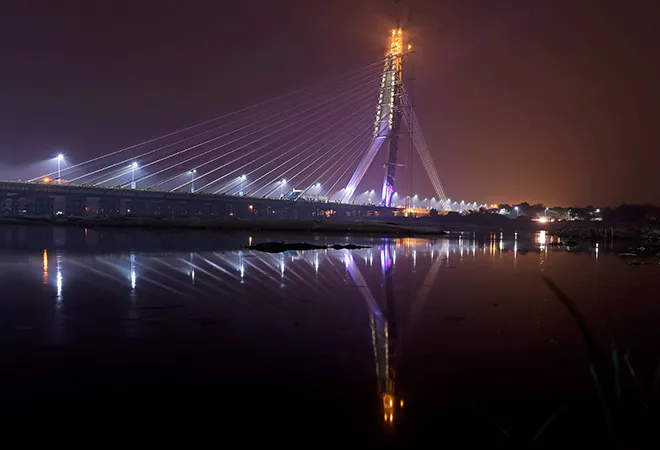-
CENTRES
Progammes & Centres
Location

Image Source: PTI
It was a year in which there were a few major glitches and nothing untowardly happened in the economy. The rupee sank ominously due to the rise in international oil prices but soon more or less stabilised with the price of the oil climbing down. India still remained the fastest growing economy at 7.1 percent growth in 2018. It is especially creditable an achievement because in 2018, China’s economic growth shrank and the shadow of protectionism marred global trade prospects. The unresolved trade war between the US and China and low global demand is making the International Monetary Fund (IMF) predict a global slowdown in 2019.
Some things, however, refused to be resolved like the agrarian distress which assumed serious proportions in 2018, leading to rallies and protest marches all over India and three times in the national capital. Even though agriculture registered a decent rate of growth of 3.8 per cent in Q2 of FY 2018-19, it did not result in reducing farm stress and farmers’ debts. The Minimum Support Prices (MSP) guaranteed by the government for 22 commodities also did not prevent farm prices to hit the rock bottom followed by distress sales. The MSP has been raised in many cases, but farm prices still rule below them as costs have soared during the year, making farming unviable for most small farmers. Low farm prices, however, helped keep the inflation low at 3.3 per cent. It, however, led to much discontent among rural youth.
Job creation also did not keep pace with high GDP growth and the year saw an increase in unemployment which according to CMIE reached nearly 7 per cent towards the year end. Clearly, the Modi government has not been able to keep its promise of creating 10 million jobs a year for the youth.
Had the industrial growth risen rapidly, it would have provided more jobs to unskilled labour, but the industrial sector performed in a lacklustre manner and only towards the year end, manufacturing growth has shown a marked uptick. It was jobs and agricultural distress that were the main issues at stake in the state elections recently and the Congress Party which claimed victory and formed the government in three States, announced loan waivers which is not a panacea for curing the problems of agriculture. Agricultural problems are too deeply entrenched and have to be addressed in a systematic manner. They include marketing reforms, better storage and transportation as well as improved irrigation facilities.
The service sector gained a little from the rupee’s depreciation and IT exports expanded, but in general the volume of such exports was lower than before. The service sector grew at a slower pace of 7.5 per cent in Q2 than in Q1 due to restrained global demand. The construction sector showed some improvement in activity after remaining dormant soon after demonetisation.
On the brighter side, India jumped 23 places to become the 77th position in the World Bank’s Ease of Doing Business in 2018. FDI came in large numbers, but it would require more reforms to have a greater FDI inflow to India. They include strengthening the power sector to ensure continuous supply of power to business, enhance the supply of land and make formal finance available in the entire rural sector.
FPIs (Foreign Portfolio Investments), on the other hand, left India in droves and 2018 proved to be the year when Rs 1 lakh crore left our shores for the West — a contrast to the Rs 2 lakh crore inflows in 2017. This was triggered partially by the rupee’s fall and also the rosier prospects that US offered in terms of higher than before GDP growth and interest rates. Their exodus further exacerbated the rupee’s fall and the balance of payments showed a significant deficit. Though some exports benefited from the rupee’s fall, all imports became more expensive. The current account deficit increased to 2.9 per cent of the GDP. Whether the fiscal deficit can be met is a question which has not been answered in a convincing manner and the latest news of the NDA government trying hard to tap the RBI’s surplus funds makes it seem that it is an uphill task for the government. The twin deficits are likely to cause problems in 2019.
The banking sector has remained stressed, a legacy of the past. The government has made big efforts to recapitalise banks but has not succeeded in eliminating the mountain of NPAs as a result of which there has been a liquidity crunch. The failed IL&FS, the mega infrastructure financing services company, added more problems in the area of finance and aggravated the problem of liquidity in the Non-Banking Financial companies (NBFCs) as they were not able to access Mutual Finds which were involved in debt papers issued by IL&FS. MFs have suffered a damage of Rs 2.4 lakh crore as large investors pulled out of fixed income schemes after the IL&FS collapse. The stressed finances have been crimping the growth of MSMEs as they borrow from NBFCs extensively.
A mega health insurance scheme, Ayushman Bharat, was started in 2018 and hopefully when it kicks off in 2019, the burden of rising costs of healthcare will be reduced specially for the low-income strata. The gap between the rich and poor widened further in 2018 and inequality of income rose, with 10 per cent of Indians getting 73 per cent of India’s wealth (Oxfam 2018). The big cities saw an increase in the number of dollar billionaires from 101 to 121. The contrast between the rich and poor with an average rural household income of Rs 8931 per month (2016-17) is not palatable and is leading to widespread discontent.
In 2018, India rejected the World Bank’s Human Capital Index in which India ranked 115th out of 157 countries. HCI measures the amount of human capital that a child born in India today can expect to attain by the age of 18.
According to the parameters of the index, a child in India will be only 44 per cent as productive as she could have been if she enjoyed complete education and full health. In other words, there are grave deficiencies in our education and healthcare systems that are preventing children from reaching their full potential. Undoubtedly, the quality of education and healthcare remained sub optimal in 2018 and grossly inadequate to cater to the needs of the people.
The informal sector continued to absorb the inflow of the rural population in search of jobs in towns and cities. Around 90 per cent of the labour force is in the informal sector which lacks any form of a social safety net and is burdened with inadequate housing, efficient and affordable transportation and job security. These major problems faced by a large chunk of the urban population remained largely unaddressed and caused discontent in 2018!
The views expressed above belong to the author(s). ORF research and analyses now available on Telegram! Click here to access our curated content — blogs, longforms and interviews.

Jayshree Sengupta was a Senior Fellow (Associate) with ORF's Economy and Growth Programme. Her work focuses on the Indian economy and development, regional cooperation related ...
Read More +
David Rusnok Researcher Strengthening National Climate Policy Implementation (SNAPFI) project DIW Germany
Read More +